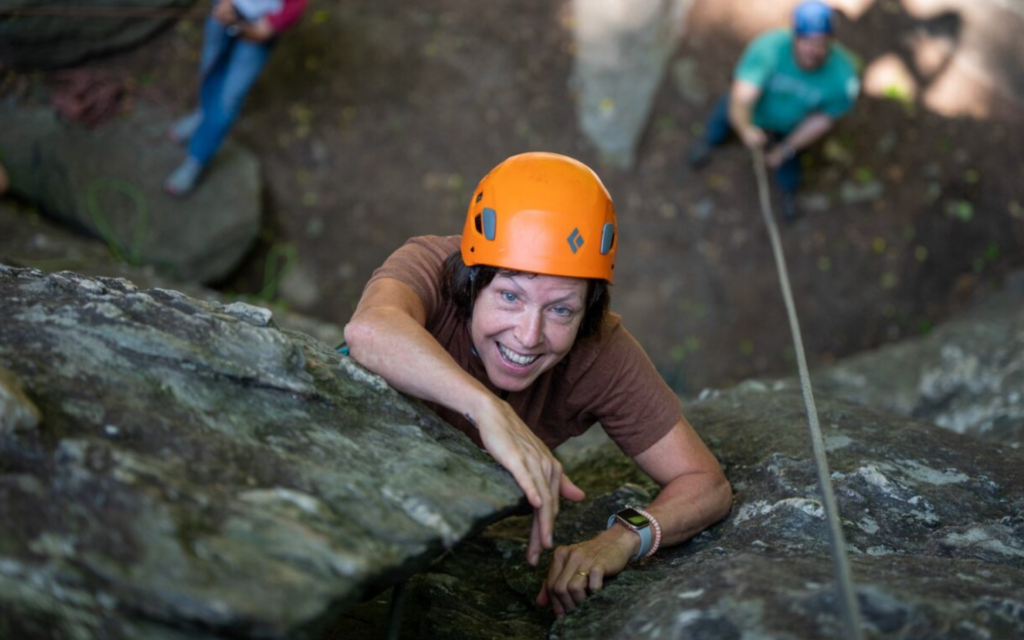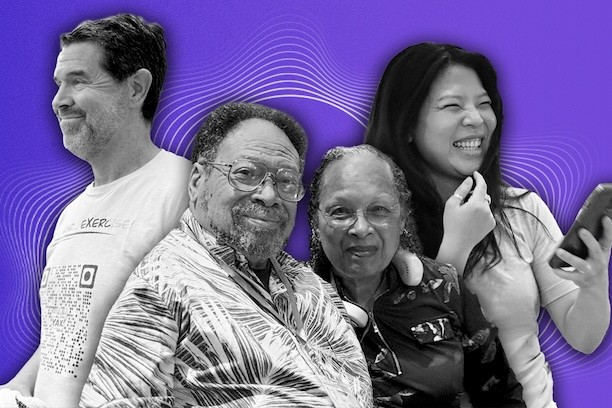When Molly Cupka was a little girl, there was a woman at her church who shook. When she asked her dad why, he told her it was Parkinson’s (PD). But, mostly, Molly spent the next two decades of her life not thinking about PD. Until Jon sent her an email. Jon Lessin was an athlete, “adrenaline junkie,” and former cardiac anesthesiologist who retired after being diagnosed with young onset Parkinson’s disease (YOPD) in 2003. He had been steadily declining when he got an idea: maybe the big movements required to scale giant rock walls could help.
Seeking private lessons, Jon emailed Sportrock Climbing Centers in Northern Virginia. Molly, who’s now the Director at Sportrock, read his message. For her, it was a no brainer. She Googled Parkinson’s and immediately said yes. It would be the start of an adventure that would take her deep into the Parkinson’s community across the nation.
Rock climbing was not Molly’s first love. It was swimming. She spent years as a competitive swimmer, eventually landing as a powerhouse student-athlete at the University of California Irvine. “I swam every day, for hours a day,” she told me. “Swimming was my identity.” As her college career wound down, the thought of leaving a sport that was so deeply intertwined with who she was felt daunting. For nearly four years, Molly had walked by the climbing wall in the UC Irvine gym. As she rounded the corner of her senior year, she decided it was time to try it. She signed up for a rock climbing class and dove in.
Molly was undeniably athletic, but that first climb was harder than she expected. She tried a route up the rocks and didn’t make it all the way through, but she knew she could. The fun of it—and the challenge—drew her in. She never stopped coming back.
After she and Jon had been climbing together for six months, they knew they were onto something. They started inviting others with Parkinson’s to join them on the wall. Vivek, the third climber they recruited, was 38 when he found out he had Parkinson’s. Quickly, he saw his fine motor skills declining. But as he started to climb, he realized that the intricate finger work and strength required to scale rock walls helped. More shocking were the results from his doctor. To monitor his progression, Vivek’s doctor would score him on a 1 to 100 scale at every appointment. To be clear, Parkinson’s is a progressive disease, so his score was always expected to dip. But after he started climbing, his score improved. His doctor was shocked, exclaiming, “No one ever improves.”
A recent study with Marymount University’s Center for Optimal Aging, conducted over a decade later, solidified what the climbers had been noticing since the beginning: when you climb, you walk better. You balance better. Your reaction time improves.
In 2022, after years of building a Parkinson’s climbing community, Molly officially turned it into a nonprofit, Up Ending Parkinson’s. On their website, they share their intention: “to bridge the gap between hope and reality for Parkinson’s patients worldwide.” Molly explained, “When you get diagnosed, your initial response is probably to go into a hole, into depression and denial. But, eventually, you’re ready to take the next step. And that step is, ‘I’m going to fight this.’ The question is: how?” Rock climbing is a way to bring that fight to life. “We want to empower people, in 10 years or 20 years, to still be able to do things. And to have fun. Just because you get a diagnosis doesn’t mean you can’t hang with your friends and have fun.”
That’s the thing about climbing: even though it’s a really good workout, it doesn’t feel like one. In fact, Molly believes that community is one of the biggest game changers for rock climbers with Parkinson’s. “Climbing is a unique sport,” Molly said, “in that everybody that’s in the facility is part of the same community. You climb, you rest, you belay. People watch each other and cheer each other on.” The more people climb, the more devoted they often become. “It gives people an identity and purpose.”
Molly sees stories like this often: there was one woman with Parkinson’s who started climbing with her husband (care partners are always invited). Her husband explained that she was experiencing Parkinson’s-related anxiety and depression and she didn’t really speak anymore. As her voice softened due to Parkinson’s, it felt to her like no one understood her. She withdrew into her own shell. But several months into climbing, she re-emerged into herself. “Now she’s huge in the group,” Molly said. “She comes 3-4 days a week. Everyone knows her. She’s super involved.” She’s in bloom.
Climbing is not just for former athletes who were diagnosed young. Up Ending Parkinson’s has expanded to 52 locations across the country, and climbers range in age from 30 to 91. (Yes, there are multiple climbers in their early 90s.) “Climbing is not hard on your joints,” Molly said, “so people tend to do it into older age.”
In the past decade or so, adaptive climbing—where climbers with disabilities have been pushing the edge of their sport—has grown. “Seeing that climbing has worked for people with one leg or no legs,” Molly said, “made me know this was possible for people with Parkinson’s.” In fact, she describes climbing as like having a “super safety net… You’re in a harness and a rope. We have ramps to get people through the doors. Anyone can try it.” It feels kind of miraculous how people with seemingly big limitations can find their groove on the rock wall.
In Up Ending Parkinson’s groups, there are climbers in wheelchairs and climbers with dementia. Almost always, the care partners of people with advanced Parkinson’s or dementia come with their loved one. Molly believes it is these care partners who can speak most to the benefits of their program. “There aren’t a lot of activities these partners can do together anymore. This is something they can share. The care partners see the benefits drastically.”
At Sportrock Climbing Centers in the DMV (District of Columbia, Maryland, and Virginia) area, Up Ending Parkinson’s offers 11 programs, all for free. Currently, there are 173 climbers impacted by Parkinson’s at these gyms. In other locations across the country, rates depend on the gym and the sponsorship the nonprofit has managed to secure. No matter what, all of Up Ending Parkinson’s programs are at least offered at a discounted rate. In the past few years, the groups in the DMV and Denver, CO, have gotten sponsored to climb outdoors, allowing them to take the joy and challenge of climbing from the gym into the wild.
Shortly after Molly and Jon started climbing together, he wrote a book about his journey entitled Tenacity. This is what Molly has learned the most from people with Parkinson’s: the power of persistence. It has changed the way she lives. “I have the gene for Alzheimer’s,” Molly said. “If I got it, it would be devastating, but I think I’d have a way better mindset now that I’ve worked with this group. Now I would know how important it is to stay physically active and have a social group.”
But what has moved her most over her many years of climbing with people with Parkinson’s are the moments of epiphany, when what seemed impossible suddenly becomes real. “There’s a lot of emotion for people when they climb,” Molly said. “It always happens a couple weeks after they start, when something clicks and they do something they didn’t think they could. That always gets me. ‘You don’t know what this did for me,’ they’ll say. ‘I can’t believe I did that.’”
Rock climbing is not a miracle cure, but it holds its own magic. And we could all use a touch of magic.


